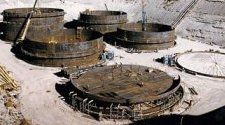
Quintessa carried out a project for CH2M Hill Hanford Group to explore the potential use of Evidence Support Logic (ESL) to assess confidence in key long-term safety issues for in-situ disposals of waste residues and contaminated land from former operations on the Hanford Site. The project also included a review of international best practice in the management of uncertainty within performance assessment.
The historical photo shows construction of radioactive waste storage tanks. There were 177 tanks built at the Hanford Site between 1943 and 1985. A major focus of DOE's mission is to clean up the legacy waste stored in these tanks.
The project culminated in a three-day technical workshop on the ESL approach, which involved USDOE employees, contractors, regulators, representatives of local and regional stakeholder groups, and observers from USDOE programmes across the USA, including Yucca Mountain, Savannah River and Washington DC. Two of the days of the workshop involved a demonstration of the use of ESL to investigate confidence in the long-term resistance to infiltration of a particular design of surface engineered barrier - reflecting a topic that has been of some concern in regulatory discussions surrounding recent environmental safety assessments.
The workshop included an 'elicitation panel' involving a cross-section of representatives from USDOE, researchers, regulators and stakeholders. In addition, opportunities were provided for the other workshop participants to reflect on the process and how successful it was in addressing key concerns, as well as to contribute to the process by drawing attention to key sources of evidence. This approach provided a unique test of the feasibility of using ESL to support the active exploration of contentious issues (particularly assumptions relating confidence in data and conceptual models) between operators and stakeholders.
This process put issues on the table for open debate.
This process requires that all participants be able to 'back up' their claims with data, with integrity, with transparency.
This tool is the first one I have seen that allows one to make some semi-quantitative evaluation of confidence.
One outcome of the project was a paper for the Waste Management 2009 conference, written together with CH2M Hill, which describes ESL, the outcome of the workshop, and potential future opportunities for its use in support of the USDOE's clean-up programme.